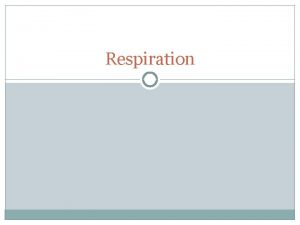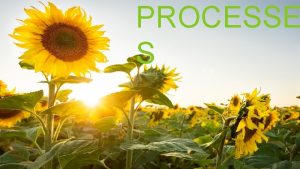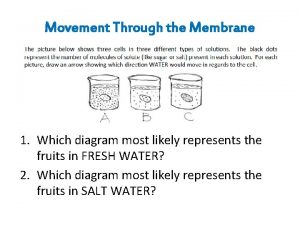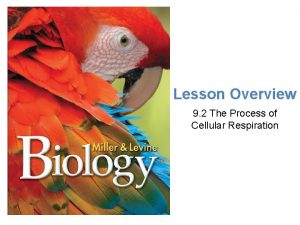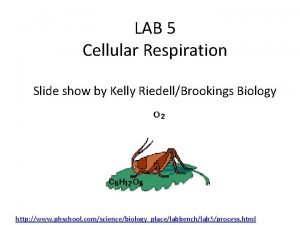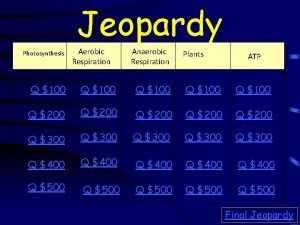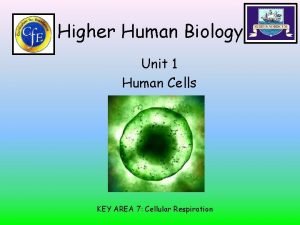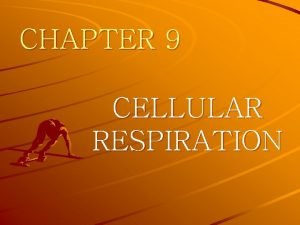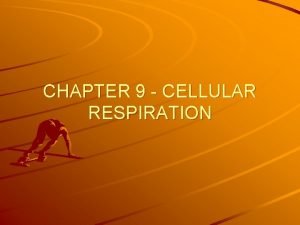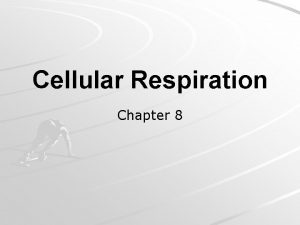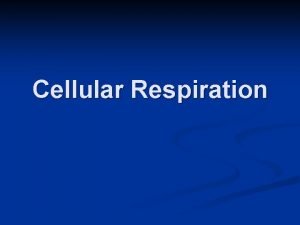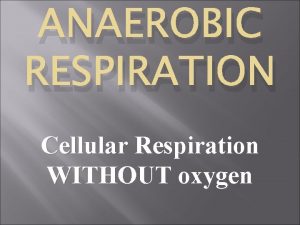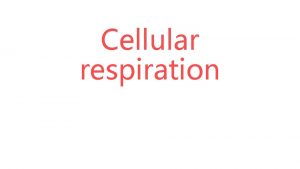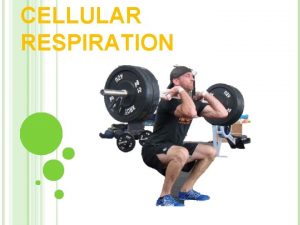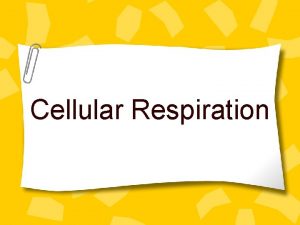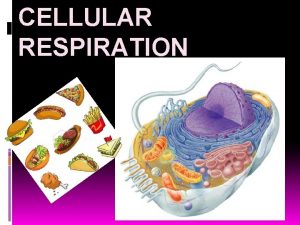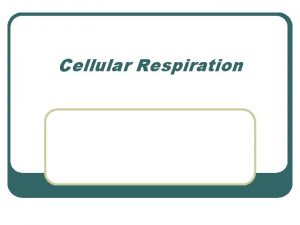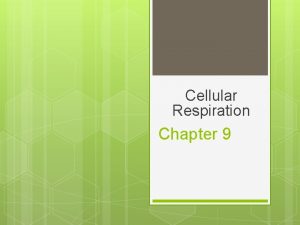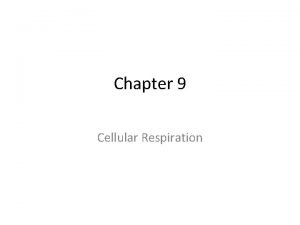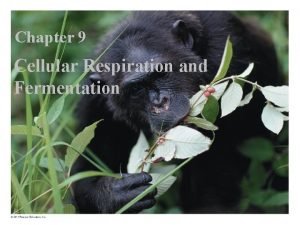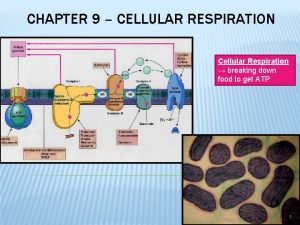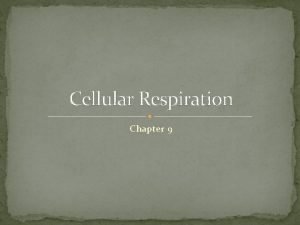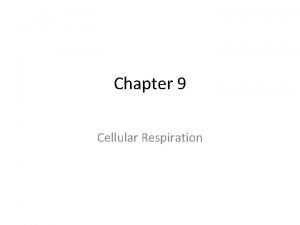CHAPTER 9 CELLULAR RESPIRATION CHAPTER 9 CELLULAR RESPIRATION






















![9 -1 [continued. . . ] Fermentation What happens when oxygen is not present? 9 -1 [continued. . . ] Fermentation What happens when oxygen is not present?](https://slidetodoc.com/presentation_image_h/a7d253c3250e2aab24a9ca5e0a9fd13f/image-23.jpg)


- Slides: 25

CHAPTER 9 CELLULAR RESPIRATION

CHAPTER 9: CELLULAR RESPIRATION 9 -1 Chemical Pathways A. Chemical Energy and Food energy Food serves as a source for _____. 3, 811 calories. 1 g of glucose (C 6 H 12 O 6) releases _______ calorie= the amount of energy needed to raise the temperature of 1 g of water 1°C. We gradually release the energy of glucose and other compounds (fats, proteins, and carbohydrates). The process begins with a pathway called_____. glycolysis If oxygen is present, glycolysis leads to cellular respiration (Krebs cycle and electron transport chain). (process = aerobic) If oxygen is not present, glycolysis leads to fermentation. (process = anaerobic)

Section 9 -1 Chemical Pathways Glucose Glycolysis Krebs cycle Fermentation (without oxygen) Electron transport 1. Alcohol or 2. Lactic acid

B. Overview of Cellular Respiration= the process that releases energy by breaking down glucose and other food molecules in the presence of oxygen. mitochondria is the Remember: the ______ the site where energy is produced. Cellular respiration takes place in the mitochondria. The equation for cellular respiration= 6 O 2 + C 6 H 12 O 6 6 CO 2 + 6 H 20 + Energy

____ Glucose stores large amounts of energy. The cell can’t release all the energy at one time. It is too much for the cell to handle. 3 main stages of cellular respiration: 1. Glycolysis (glyco= sugar; lysis=break apart) 2. Krebs Cycle 3. Electron Transport Chain (ETC)

Section 9 -2 Flowchart Cellular Respiration Glucose (C 6 H 1206) + Oxygen (02) Glycolysis Krebs Cycle Electron Transport Chain Carbon Dioxide (CO 2) + Water (H 2 O)

Respiration: An Overview Section 9 -1 Mitochondrion Electrons carried in NADH Pyruvic acid Glucose Glycolysis Krebs Cycle Electrons carried in NADH and FADH 2 Electron Transport Chain Mitochondrion Cytoplasm 2 2 34 http: //scholar. hw. ac. uk/site/biology/activity 3. asp

C. Glycolysis= the process in which one molecule of glucose is broken in half, producing two molecules of pyruvic acid, a 3 -carbon compound. This pathway does not require oxygen Prokaryotes depend on this process alone for ATP. Section 9 -1 Glucose PGAL (Phosphoglyceraldehyde) 2 Pyruvic acid To the electron transport chain

1. ATP Production 2 ATP Use__ 4 ATP Makes __ 2 ATP Net gain is __ 2. NADH Production NAD+ (nicotinamide adenine dinucleotide) is an Electron carrier _______. NADH (an electron NAD+ accepts electrons to make ______ carrier). 2 NADH are produced. In glycolysis, ____ NADH will carry its’ electrons to the electron transport chain.

3. Overall, Glycolysis produces 2 ATP “Net” (energy molecules) 2 NADH (electron carriers) 2 Pyruvic Acid (3 -C sugars)

9 -2 The Krebs Cycle and Electron Transport A. The Krebs Cycle (aka: Citric Acid Cycle) 1. Pyruvate (pyruvic acid) oxidation 2. Energy Extraction

Hans Krebs Named after _____. Occurs in the Mitochondria (therefore this process only Eukaryotes occurs in _____) Krebs cycle= process where pyruvic acid is broken down into carbon dioxide in a series of energy-extracting reactions. Krebs cycle begins when pyruvic acid enters mitochondria.

1. Pyruvic acid Oxidation In this process, it produces the following from glucose: 2 acetyl-Co. A (2 -C sugar) 2 NADH (electron carriers) 2 Carbon dioxide (waste product)

2. Energy Extraction

Acetyl Co. A ( 2 -C ) binds with a Oxaloacetic acid ( 4 -C ) molecule to form Citric Acid ( 6 -C ). . . Hence, the name Citric Acid Cycle. Citric Acid is oxidized (by NAD+ and FAD) through a series of reactions that finally produces Oxaloacetic Acid again. 2 times per Glucose The Krebs Cycle runs __ molecule. (Once per pyruvic acid. ) This process produces (per glucose molecule): 6 NADH (electron carriers-go to ETC) - ___ 2 FADH 2 (electron carriers-go to ETC) - ___ 2 ATP (energy-used by cell to do work) - ___ 4 CO 2 (waste product- gets exhaled)

B. Electron Transport (ETC) The Electron Transport Chain= process Section 9 -2 that uses the high-energy electrons from the Krebs cycle to convert ADP into ATP. Electron Transport Hydrogen Ion Movement Channel Mitochondrion Intermembrane Space ATP synthase Inner Membrane Matrix ATP Production

The Process: A. Electron Transport 1. Glycolysis and the Krebs Cycle deliver their NADH ____ and _______ FADH 2 to the matrix of the mitochondria. 2. NADH and FADH 2 donate their high energy electrons to the ETC. NADH → NAD+ + H+ + 2 e- FADH 2→ FAD + 2 H+ + 2 e- (recycled) (go to intermembrane space) (passed to ETC)

3. Electrons are passed from carrier to carrier in the inner membrane. Oxygen is the 4. At the end of the chain, ____ final electron acceptor. 5. Oxygen uses the electron to covalently bond with hydrogen forming water. (oxygen is reduced)

B. Hydrogen Ion Movement 1. As the high energy electrons are transported down the chain, their energy is used to push H+ from the matrix, through the inner membrane, to the intermembrane space. 2. It takes 2 e- to move 1 H+ intermembrane space becomes (+) positively 3. The _______ charged. 4. The _______ matrix becomes (-) negatively charged.

C. ATP Production 1. Hydrogen ions return to the matrix through the enzyme ATP synthase. 2. As Hydrogen passes, the enzyme grabs a phosphate and attaches it to ADP to become ATP. D. This process produces: - 34 ATP - water

C. The Totals Per Glucose molecule 3 ATP ***note: each NADH produces __ 2 ATP each FADH 2 produces __ LOCATION ATP NADH FADH 2 cytoplasm 2 2 0 ------ KREBS CYCLE: Pyruvic acid oxidation → matrix 0 2 0 Carbon dioxide Energy Extraction → matrix 2 6 2 Inner Membrane (Cristae) Carbon dioxide 34 0 0 water 36 10 2 GLYCOLYSIS ELECTRON TRANSPORT CHAIN TOTALS (net) BYPRODUCTS -2 ATP (transport of pyruvic acid into mitochondria)

D. Comparing Photosynthesis and Cellular Respiration Photosynthesis Function Location Reactants Products Equation Cellular Respiration Energy Capture Energy Release Chloroplasts Mitochondria H 2 O and CO 2 C 6 H 12 O 6 and O 2 H 2 O and CO 2 6 H 2 O + 6 CO 2 → C 6 H 12 O 6 + 6 O 2 → 6 H 2 O + 6 CO 2
![9 1 continued Fermentation What happens when oxygen is not present 9 -1 [continued. . . ] Fermentation What happens when oxygen is not present?](https://slidetodoc.com/presentation_image_h/a7d253c3250e2aab24a9ca5e0a9fd13f/image-23.jpg)
9 -1 [continued. . . ] Fermentation What happens when oxygen is not present? Anaerobic process Fermentation= release of energy from food molecules by producing ATP in the absence of oxygen. Glycolysis still occurs in the cytoplasm producing pyruvic acid. The pyruvic acid can go through one of two types of fermentation: Alcoholic Fermentation 1. _____ Occurs in yeast cells and other microorganisms. Pyruvic acid + NADH → alcohol + CO 2 + NAD+ Important to bakers and brewers. CO 2 released causes bread to rise ____

2. ______ Lactic Acid Fermentation Section 9 -1 Glucose Pyruvic acid Lactic acid Produced in our muscle cells when oxygen levels are too low Lactic Acid causes the burning feeling. Build up of _____ NAD+ is regenerated to keep running glycolysis. ______ Prokaryotes are used to make food because they do produce lactic acid. Some examples: -cheese -yogurt -kimchi -sauerkraut -sour cream -buttermilk -pickles

COMPARISON OF FERMENTATION TO CELLULAR REPIRATION Lactic Acid glucose Alcoholic glucose Cellular respiration glucose glycolysis (pyruvic acid) carbon dioxide lactic acid alcohol water 2 ATP 38 ATP (net 36) glycolysis (pyruvic acid)
 Chapter 8 section 3: cellular respiration
Chapter 8 section 3: cellular respiration The stages of cellular respiration
The stages of cellular respiration Explain how amp stimulates cellular respiration
Explain how amp stimulates cellular respiration Chapter 9: cellular respiration: harvesting chemical energy
Chapter 9: cellular respiration: harvesting chemical energy Cellular respiration redox
Cellular respiration redox The gray-brown haze often found over large cities is called
The gray-brown haze often found over large cities is called Chemiosmosis steps
Chemiosmosis steps Types of respiration
Types of respiration Fermentation definition biology
Fermentation definition biology Why is cellular respiration important
Why is cellular respiration important Complementary processes
Complementary processes What's the equation for cellular respiration
What's the equation for cellular respiration Amloplast
Amloplast Photosynthesis and cellular respiration vocabulary
Photosynthesis and cellular respiration vocabulary Photosynthesis recipe card
Photosynthesis recipe card Electron carriers in cellular respiration
Electron carriers in cellular respiration Overview of cellular respiration
Overview of cellular respiration Respiration overview
Respiration overview Cellular respiration
Cellular respiration Overview of cellular respiration
Overview of cellular respiration Lab bench cellular respiration
Lab bench cellular respiration What is the word equation for cellular respiration
What is the word equation for cellular respiration Higher human biology cellular respiration
Higher human biology cellular respiration Formula for cellular respiration
Formula for cellular respiration What are the reactants and products of photosynthesis
What are the reactants and products of photosynthesis Cellular respiration releases
Cellular respiration releases







